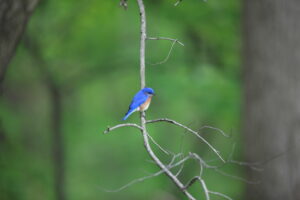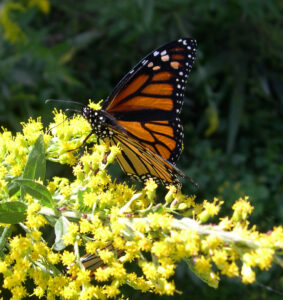This week’s nature kits focus on migration. Twice a year creatures such as certain birds and butterflies make thousand-mile journeys between North and South America. After today’s activity you will understand some of the unique challenges and needs of migrating animals, and you will learn how you can help them safely make their journeys.
Every Saturday, Nature Kits are given out on a first-come, first-served basis from 10:00 am–12:00 pm. Nature Kits focus on a different theme each week and are meant to be done along our trails and given back once completed. If you can’t make it out to the Center to pick up a kit, make sure to check our blog each week for ways to get in some nature exploration at home.
Activity #1: Migration Hopscotch:
- Draw a hopscotch board with 10 numbered squares on the pavement with chalk.
- Then gather 8-10 items that will be placed on the squares later.
- The items can be anything that you find—sticks, pinecones, toys, rocks, utensils, etc.
- After drawing your board, stand in front of the #1 square; you are a bird starting your migration from north to south.
- Each square represents a stopover-site between North America (Canada) and South America.
- Migrate southward on the course by hopping from square to square until you arrive past square #10.
- Before you turn to head back north, have your grownup place 2 items on 2 different squares—these are sites that no longer have resources for you to use.
- Hop back north without stepping on the squares that have these props.
- Continue placing more props on empty squares before every new round until it is impossible to migrate due to lack of squares (resources).
- When the game is done, think about the importance of resources such as food, water, and land to a bird’s successful migration.
- What happens if those resources are taken away? How can we save resources for migrating birds?
Activity #2: Nesting Tree Memory Game
Did you know that some birds, such as swallows, return to one tree year after year to nest? Scientists are still unsure how they are able to find the same tree after migrating thousands of miles away from their warm overwinter spots in the south. Do you think you would be able to remember your nesting tree?
-
- In your yard or a park, choose one tree that will be your final destination nesting tree.
- Then create a trail to get to your final tree, finding 4 trees along the way to “rest” at before arriving at your destination.
- Touch each tree before moving onto the next one, as your grownup records the order of the trees that you stopped at.
- After you arrive at your nesting tree, leave the area for at least 10 minutes, then return and try to perfectly repeat the order of the trees you touched on your trail to your nesting tree.
- Were you able to remember your route precisely?
Activity #3: Migration Resources Scavenger Hunt
Nearly all migrating creatures need to make stops along the way to their destination to replenish on water, food, and rest.
- Choose a migrating bird you would like to become.
- Think about what resources this bird would need during its journey – what food do you eat, and where would you find it?
- Where do you like to rest – in water, in a tree, in a meadow?
- What about drinking water?
- Plan out places in your yard or a park that you would need to visit to survive your flight.
- In the table below, record the resources you find by checking off boxes with a pencil.
Migration Resources Scavenger Hunt
| Resource
(up to 3 sites) |
Check box when you find this resource | Check box when you find this resource | Check box when you find this resource |
| Food (must find at least 1)
What does your bird eat? Examples: insects, worms, berries, plants |
|||
| Drinking Water (must find at least 2) | |||
| Shelter or a place to rest (must find at least 1) |
—Rebecca Deegan, Environmental Educator


